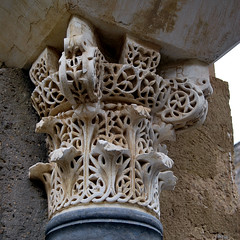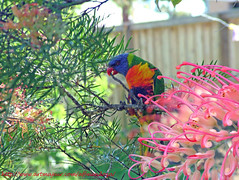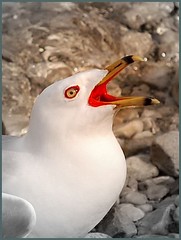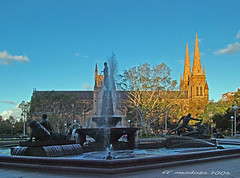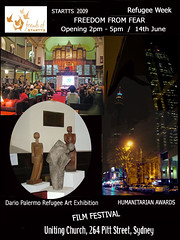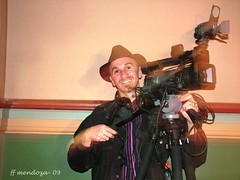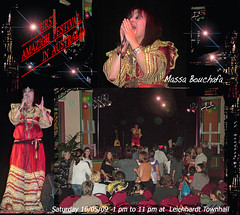Me gustan bastante las presentaciones de Javier donde simpre alia series de fotos de arquitectura ,con comentarios y datos sobre su contexto e historia .
11 Madinat al-Zahra Edificio Basilical Superior 15342
Medina Azahara “Madinat al-Zahra” Carretera de Cordoba a Palma del Río, km. 5,5. Córdoba
La investigación sobre Madinat al-Zahra y el proceso para su recuperación son recientes, las primeras excavaciones se realizan en 1911. En ese periodo, y especialmente bajo la dirección del arquitecto Félix Hernández, se excavó la parte central del Alcázar, con una superficie de unas 10,5 hectáreas, y se definieron las líneas básicas del urbanismo del palacio acometiendo, además, importantes restauraciones como la del Salón de Abd al-Rahman III. En 1985 pasa a depender de la Junta de Andalucía como Conjunto Arqueológico con nuevos instrumentos de protección y gestión. Una ciudad islámica de 112 hectáreas mandada construir, a cargo del maestro alarife Maslama ben Abadía, por el primer califa de al-Andalus, Abd al-Rahman III, en el año 936 ó 940, como residencia personal y sede del gobierno.
Situada entre las faldas de Sierra Morena, al pie de la montaña Yebel al-Arus (“Monte de la Desposada”), y el valle del Guadalquivir, se dispone en terrazas para adaptarse a la pendiente del terreno, la primera de las cuales corresponde a la zona residencial del califa, seguida por la zona oficial, administrativa y jardines..., hasta albergar las viviendas y talleres del pueblo, junto con la mezquita Aljama, en la parte mas baja, separadas de las dos terrazas anteriores por una muralla que las aislar del conjunto palatino. La zona palaciega albergaba las viviendas de los dignatarios más importantes y los órganos administrativos del Estado, que fueron trasladados desde Córdoba. Durante los reinados de Abd al-Rahman III y al-Hakam II, la ciudad se convirtió en la capital de al-Andalus. Entre los años 1010 y 1013, durante la guerra civil que puso fin al califato omeya, se inició su abandono y saqueo, y sus restos se utilizaron como cantera para otras construcciones. Es considerada como una de las cumbres del arte islámico, tanto por su estructura y disposición urbana como por las soluciones arquitectónicas empleadas, la diversidad de sus materiales y la extraordinaria riqueza y calidad decorativa. Frente a la idea laberíntica y caótica característica del urbanismo musulmán, Medina Azahara presenta una planta rectangular de 1500 por 750 metros, con trazado ortogonal, red de alcantarillado y abastecimiento de agua perfectamente planificados. Está considerada la ciudad de nueva planta con mayor superficie construida de una sola vez en el Mediterráneo.
Edificio Basilical Superior
Este gran salón, de mediados del siglo X, debió ser la sede de algún órgano, aún sin determinar, de la administración califal. Edificio basilical de cinco naves separadas por arcadas soportadas por columnas, y una nave transversal que se abre sobre una amplia plaza, no ajardinada en su origen. Conserva prácticamente íntegro su pavimento original de ladrillo. El revestimiento de muros y arcos se realiza combinando mortero pintado de almagra y blanco
javier1949
martes, 30 de junio de 2009
lunes, 29 de junio de 2009
Back to my Roots (Ben Heine)
(High resolution version of this image for printing purposes available in "All Sizes")
As I Am
By Peter S. Quinn
As I am
I am your tender way
Someone to follow
Earth in its gray
Love song of the deep
As hours pass by
Hold on and keep
Knots to lose and try
You are for me
Night with its stars
Someone to follow
Winter’s top isobars
Can’t you hear me singing
Like a bird in a tree
To your heart bringing
Something of me
As I am
Without any taken
Winter ways hollow
Through the darks waken
No one but you
Understands this
From the dim dim blue
Outside in vast abyss
--------------
The poem appeared on www.poemhunter.com/peter-s-quinn
As I Am
By Peter S. Quinn
As I am
I am your tender way
Someone to follow
Earth in its gray
Love song of the deep
As hours pass by
Hold on and keep
Knots to lose and try
You are for me
Night with its stars
Someone to follow
Winter’s top isobars
Can’t you hear me singing
Like a bird in a tree
To your heart bringing
Something of me
As I am
Without any taken
Winter ways hollow
Through the darks waken
No one but you
Understands this
From the dim dim blue
Outside in vast abyss
--------------
The poem appeared on www.poemhunter.com/peter-s-quinn
Mi jardin - garden 2005
Loriinae
Lories and Lorikeets
Mi jardin lo visitan simpaticos loritos.
de vez en cuando aproveho para hacerles una foto ,
Esta realzada digitalmente ,
y el efecto me parece bien
aunque deje algunas claves para distinguirla de una foto directa ,
Con lo digital habria que preguntarse donde empieza y acaba una foto directa y otra realzada o transformada ?
Lories and Lorikeets,series
ffm 2004/2009
Lories and Lorikeets
Mi jardin lo visitan simpaticos loritos.
de vez en cuando aproveho para hacerles una foto ,
Esta realzada digitalmente ,
y el efecto me parece bien
aunque deje algunas claves para distinguirla de una foto directa ,
Con lo digital habria que preguntarse donde empieza y acaba una foto directa y otra realzada o transformada ?
Lories and Lorikeets,series
ffm 2004/2009
viernes, 26 de junio de 2009
Red -photo and short poem = Eric Ashford
Red
I am fire and flesh
red in my hunger.
I live in the flame
of joy and fright.
por Eric Ashford
I am fire and flesh
red in my hunger.
I live in the flame
of joy and fright.
por Eric Ashford
jueves, 18 de junio de 2009
martes, 16 de junio de 2009
Sidney Hide park
Sidney Hide park
Recorridos/ Sydney centro
Evening at
Catedral y fuente de Hyde Park
Sidney- Australia: .
Cathedral from Hyde Park - Australia.
Hyde Park: History
Hyde Park takes its name from a park in London. Hyde Park in London is one of the largest parks in Central London.
Hyde Park began as the city’s first race course and later functioned as a cricket ground for a brief period.
Hyde Park: Features
The most identifiable feature of Hyde Park is the grand Archibald Fountain. The monument was inaugurated in 1932 as a tribute to those Australian soldiers who lost their lives during the Great War in France. Archibald Fountain is regarded as one of the finest public fountains in Australia.
Archibald Fountain
From Wikipedia, the free encyclopedia
Archibald Fountain, Hyde Park, Sydney
The Archibald Fountain, properly called the J.F. Archibald Memorial Fountain, widely regarded as the finest public fountain in Australia, is located in Hyde Park, in central Sydney, New South Wales. It is named after J.F. Archibald, owner and editor of The Bulletin magazine, who bequeathed funds to have it built. Archibald specified that it must be designed by a French artist, both because of his great love of French culture and to commemorate the association of Australia and France in World War I. He imagined its civic design and ornamentation developing to rival his dream city Paris. The artist chosen was Francois Sicard.
The fountain was unveiled on 14 March 1932 by the Lord Mayor of Sydney, Samuel Walder.
------
Sicard was one of the foremost sculptors of his day, a classically educated artist, whose inspiration was derived, at least in part, from his study of classical Greek and Roman art and literature. In submitting his proposal for the design of the sculptural groups, Sicard wrote:" Apollo represents the Arts (Beauty and Light). Apollo holds out his right arm as a sign of protection, and spreads his benefits over all Nature, whilst he holds the Lyre in his left hand. Apollo is the warmth which vivifies, giving life to all Nature. At the touch of his rays, men awake, trees and fields become green, the animals go out into the fields, and men go to work at dawn.
The ancient Pliny adored the sun, symbol of Life. It is on this account that I wished this figure to be the chief one in the memorial.
At Apollo's feet the star of day is indicated by a semicircle, of which the rays spread out in jets of light (the rising sun). The horses' heads represent the horses of Apollo's chariot. Out of their nostrils the water will fall into the first basin, to fall from there into the second, and run away into the large basin.
The large basin is divided into three groups. One represents Diana, goddess of purity, of peaceful nights, symbol of charity; the ideal which watches over mortals - all that stands for poetry and harmony. The second group symbolises the good things of the earth - it is the young god of the fields and pastures, of the pleasure of the countryside. The third group represents sacrifice for the public good. Theseus, vanquisher of the Minotaur. The spirit triumphs over bestiality. Theseus delivers his country from the ransom which it had to pay to this monster. It is the sacrifice of himself for the good of humanity. Between these groups tortoises throw jets of water. The fountain is electrically illuminated and floodlighted at night."
It depicts Apollo, representing beauty and the arts, on a central column holding out his right arm as a sign of protection over all nature. On the three plinths radiating from the central column there are figures representing Diana, the goddess of purity; a group representing the good things of the earth; Theseus slaying a Minotaur, representing the sacrifice for the good of humanity."
Interestingly, Sicard quotes Pliny as one of the ancient Roman sources for the modern understanding of the qualities supposedly represented by the gods. Rather than merely using the visual examples of works such as those by Pheidias, the iconic sculptor of classical Athens, whose free standing and frieze statuary represent the acme of the classical depiction of the human form in larger-than life bronze or marble, Sicard used literary sources to explain the symbology behind the form.
His choice of classical figures was in keeping with the European tradition of the sculpture and architecture of the precinct of Hyde Park. There is no indication in the writings of Sicard, or indeed, in the appraisal of his work, that there was any intention to link the figures in the sculptural groups with any religious or sexual themes.
Over the years the Archibald Fountain has been a chosen spot for photos, buskers, political rallies and just as a meeting place. Park benches are provided nearby, making it a popular location for city workers at lunchtime.
An imposing stone structure of decorated geometrical Gothic design, with twin towers above its main southern entrance, rises along the northeastern side of Hyde Park in the heart of Sydney. This is one of the more notable and historic Sydney churches, a Sydney landmark.
St Mary's Cathedral, whose foundation stone was laid by Archbishop Bede Polding in 1868, rises from the site of the first Sydney cathedral built earlier in the century but which had gone up in flames in 1865.
It is the mother church of Australian Catholicism.
St Mary's Cathedral lies in an area bounded by Hyde Park and the underground St James station in the west, government buildings in the north, The Domain in the northeast and east, and Cathedral Rd and Phillip Park in the south.
In the heart of the city
Hyde Park, cut into two sections by Park St which leads east to Kings Cross, is almost certainly the very heart of the city of Sydney.
St Mary's Cathedral itself is almost completely surrounded by swards of green.
chers ff
Recorridos/ Sydney centro
Evening at
Catedral y fuente de Hyde Park
Sidney- Australia: .
Cathedral from Hyde Park - Australia.
Hyde Park: History
Hyde Park takes its name from a park in London. Hyde Park in London is one of the largest parks in Central London.
Hyde Park began as the city’s first race course and later functioned as a cricket ground for a brief period.
Hyde Park: Features
The most identifiable feature of Hyde Park is the grand Archibald Fountain. The monument was inaugurated in 1932 as a tribute to those Australian soldiers who lost their lives during the Great War in France. Archibald Fountain is regarded as one of the finest public fountains in Australia.
Archibald Fountain
From Wikipedia, the free encyclopedia
Archibald Fountain, Hyde Park, Sydney
The Archibald Fountain, properly called the J.F. Archibald Memorial Fountain, widely regarded as the finest public fountain in Australia, is located in Hyde Park, in central Sydney, New South Wales. It is named after J.F. Archibald, owner and editor of The Bulletin magazine, who bequeathed funds to have it built. Archibald specified that it must be designed by a French artist, both because of his great love of French culture and to commemorate the association of Australia and France in World War I. He imagined its civic design and ornamentation developing to rival his dream city Paris. The artist chosen was Francois Sicard.
The fountain was unveiled on 14 March 1932 by the Lord Mayor of Sydney, Samuel Walder.
------
Sicard was one of the foremost sculptors of his day, a classically educated artist, whose inspiration was derived, at least in part, from his study of classical Greek and Roman art and literature. In submitting his proposal for the design of the sculptural groups, Sicard wrote:" Apollo represents the Arts (Beauty and Light). Apollo holds out his right arm as a sign of protection, and spreads his benefits over all Nature, whilst he holds the Lyre in his left hand. Apollo is the warmth which vivifies, giving life to all Nature. At the touch of his rays, men awake, trees and fields become green, the animals go out into the fields, and men go to work at dawn.
The ancient Pliny adored the sun, symbol of Life. It is on this account that I wished this figure to be the chief one in the memorial.
At Apollo's feet the star of day is indicated by a semicircle, of which the rays spread out in jets of light (the rising sun). The horses' heads represent the horses of Apollo's chariot. Out of their nostrils the water will fall into the first basin, to fall from there into the second, and run away into the large basin.
The large basin is divided into three groups. One represents Diana, goddess of purity, of peaceful nights, symbol of charity; the ideal which watches over mortals - all that stands for poetry and harmony. The second group symbolises the good things of the earth - it is the young god of the fields and pastures, of the pleasure of the countryside. The third group represents sacrifice for the public good. Theseus, vanquisher of the Minotaur. The spirit triumphs over bestiality. Theseus delivers his country from the ransom which it had to pay to this monster. It is the sacrifice of himself for the good of humanity. Between these groups tortoises throw jets of water. The fountain is electrically illuminated and floodlighted at night."
It depicts Apollo, representing beauty and the arts, on a central column holding out his right arm as a sign of protection over all nature. On the three plinths radiating from the central column there are figures representing Diana, the goddess of purity; a group representing the good things of the earth; Theseus slaying a Minotaur, representing the sacrifice for the good of humanity."
Interestingly, Sicard quotes Pliny as one of the ancient Roman sources for the modern understanding of the qualities supposedly represented by the gods. Rather than merely using the visual examples of works such as those by Pheidias, the iconic sculptor of classical Athens, whose free standing and frieze statuary represent the acme of the classical depiction of the human form in larger-than life bronze or marble, Sicard used literary sources to explain the symbology behind the form.
His choice of classical figures was in keeping with the European tradition of the sculpture and architecture of the precinct of Hyde Park. There is no indication in the writings of Sicard, or indeed, in the appraisal of his work, that there was any intention to link the figures in the sculptural groups with any religious or sexual themes.
Over the years the Archibald Fountain has been a chosen spot for photos, buskers, political rallies and just as a meeting place. Park benches are provided nearby, making it a popular location for city workers at lunchtime.
An imposing stone structure of decorated geometrical Gothic design, with twin towers above its main southern entrance, rises along the northeastern side of Hyde Park in the heart of Sydney. This is one of the more notable and historic Sydney churches, a Sydney landmark.
St Mary's Cathedral, whose foundation stone was laid by Archbishop Bede Polding in 1868, rises from the site of the first Sydney cathedral built earlier in the century but which had gone up in flames in 1865.
It is the mother church of Australian Catholicism.
St Mary's Cathedral lies in an area bounded by Hyde Park and the underground St James station in the west, government buildings in the north, The Domain in the northeast and east, and Cathedral Rd and Phillip Park in the south.
In the heart of the city
Hyde Park, cut into two sections by Park St which leads east to Kings Cross, is almost certainly the very heart of the city of Sydney.
St Mary's Cathedral itself is almost completely surrounded by swards of green.
chers ff
Refugee week prese b2
Operning "Dario Palermo,Refugee Art Exhibtion 2009.
Apertura exposicion
Film Festival and Humanitarian Awards alongside the exhibtion.
Festival de cortometrages ,Premios humanitarios
Uniting Church ,Sydney
--------------
Friends of STARTTS is an Australian registered charity that supports the work ofSTARTTS (NSW Service for the Treatment and Rehabilitation of Torture and Trauma Survivors).
Grupo de apoyo a STARTTS (Servicio de Tratamiento y Rehabilitacion de Victimas de la Tortura y Trauma)
=======
El publico asistió numeroso .los cortometrajes fueron extraordinarios ,personalmente solo pude ver dos de ellos , que me crearon un gran impacto .
me sigue resultando incompresible el tratamiento de algunas zonas de nuestro planeta hacia otras personas con cualquier excusa , la persecución y los malos tratos siguen siendo frecuentes y de la partida , Ante estos los medios de los que quieren ayudar parecen en ciertos casos bien derisorios ,pero su persistencia da frutos . Romper la indiferencia de los que tiene el privilegio de vivir en sociedades mas estables y de sus responsables socio políticos
es ya una manera de ayudar estos cortometrajes ciertamente abren la puertas a esa conciencia tan necesaria para frenar los abusos que se pasean
impertérritos hacia ciertas personas o grupos étnicos, religiosos... en por desgracia tantas partes del mundo .
La exposición destaco por la variedad de trabajos muchos de ellos con un innegable carácter expresionista ,
Al finalizar la inauguración los numeroso voluntarios se pusieron al trabajo para desmontar todo lo necesario al festival de cortometrajes la exposición de arte seguira toda la semana .
Para los próximos años les gustaría poder producir un dvd con los cortometrajes, asi me comentaron los organizadores .
ffmendoza
Apertura exposicion
Film Festival and Humanitarian Awards alongside the exhibtion.
Festival de cortometrages ,Premios humanitarios
Uniting Church ,Sydney
--------------
Friends of STARTTS is an Australian registered charity that supports the work ofSTARTTS (NSW Service for the Treatment and Rehabilitation of Torture and Trauma Survivors).
Grupo de apoyo a STARTTS (Servicio de Tratamiento y Rehabilitacion de Victimas de la Tortura y Trauma)
=======
El publico asistió numeroso .los cortometrajes fueron extraordinarios ,personalmente solo pude ver dos de ellos , que me crearon un gran impacto .
me sigue resultando incompresible el tratamiento de algunas zonas de nuestro planeta hacia otras personas con cualquier excusa , la persecución y los malos tratos siguen siendo frecuentes y de la partida , Ante estos los medios de los que quieren ayudar parecen en ciertos casos bien derisorios ,pero su persistencia da frutos . Romper la indiferencia de los que tiene el privilegio de vivir en sociedades mas estables y de sus responsables socio políticos
es ya una manera de ayudar estos cortometrajes ciertamente abren la puertas a esa conciencia tan necesaria para frenar los abusos que se pasean
impertérritos hacia ciertas personas o grupos étnicos, religiosos... en por desgracia tantas partes del mundo .
La exposición destaco por la variedad de trabajos muchos de ellos con un innegable carácter expresionista ,
Al finalizar la inauguración los numeroso voluntarios se pusieron al trabajo para desmontar todo lo necesario al festival de cortometrajes la exposición de arte seguira toda la semana .
Para los próximos años les gustaría poder producir un dvd con los cortometrajes, asi me comentaron los organizadores .
ffmendoza
domingo, 7 de junio de 2009
REFUGEE WEEK PRESENTATION 1
REFUGEE WEEK PRESENTATION 1
Acerca de la Semana de los Refugiados - Titulo de este año ; Libres del miedo
La Semana de los refugiados es dedicada al reconocimiento y celebración de la increíble contribución que hacen los refugiados, así como aquellos que les apoyan a la sociedad australiana a través de su creatividad y persistencia . Se celebrará del 14 al 20 de junio de 2009.
Esta serie de eventos tiene como objetivo importante:
El promover y Aumentar en las diferentes secciones de la comunidad la comprensión de la significancia de ser un refugiado.
Información sobre uno de estos eventos , (en este varios compañeros artistas de la comunidad ibero americana de Sydney, participan)
Para marcar esta semana, Amigos de STARTTS, grupo de apoyo a STARTTS (Servicio de Tratamiento y Rehabilitación de Víctimas de la Tortura y Trauma) presentan un evento que celebra la diversidad cultural a través de los triunfos y diversidad de talentos que han aportado a la sociedad australiana ; los solicitantes de asilo, los refugiados y por supuesto aquellos que los apoyan .
El evento se celebrará en la Iglesia Unitaria, Sydney, que generosamente ofrecieron su apoyo a la celebración.
Consta de una exhibición de arte; toma el nombre de un recientemente fallecido artista latino, Darío Palermo escultor de talento, persona amigable y gran amigo de la solidaridad y la cultura en sus diversas formas .
Desde el 2006 la muestra toma su nombre y en ese año se le hizo un homenaje con la presencia de amigos allegados y familiares ,el alma encogida
cada sucesivo año a partir de esa trágica perdida se presentan artistas de la comunidad latina, recordando muy especialmente a la persona ,el artista y en su nombre a todos aquellos que ponen de manera modesta y persistente , parte de su energía y creatividad a hacer avanzar la causa humanitaria y la solidaridad por encima de nuestras diferencias .
Este evento consta también de una presentación de distinciones a las personas que se destacan en el trabajo humanitario enfocado a los refugiados .
así como de un festival de cine ; cortometrajes y documentales cortos con un alto enfoque que alía la calidad y el humanismo que traspasa la pantalla
y toca la emoción de los privilegiados espectadores al acto .
Detalles del evento
Opening 2 pm / 5 pm 14 th june
Uniting Church, 264 Pitt Street, Sidney
Dario Palermo Exposición de arte - Festival de Cine - Apertura de los Premios Humanitarios
----------------------------
Durante la semana Habrá cientos de eventos alrededor de Australia
Este enlace contiene una lista de esos eventos :
www.refugeecouncil.org.au/newsevents/index.html
-----------------------------------------
Acerca de la Semana de los Refugiados - Titulo de este año ; Libres del miedo
La Semana de los refugiados es dedicada al reconocimiento y celebración de la increíble contribución que hacen los refugiados, así como aquellos que les apoyan a la sociedad australiana a través de su creatividad y persistencia . Se celebrará del 14 al 20 de junio de 2009.
Esta serie de eventos tiene como objetivo importante:
El promover y Aumentar en las diferentes secciones de la comunidad la comprensión de la significancia de ser un refugiado.
Información sobre uno de estos eventos , (en este varios compañeros artistas de la comunidad ibero americana de Sydney, participan)
Para marcar esta semana, Amigos de STARTTS, grupo de apoyo a STARTTS (Servicio de Tratamiento y Rehabilitación de Víctimas de la Tortura y Trauma) presentan un evento que celebra la diversidad cultural a través de los triunfos y diversidad de talentos que han aportado a la sociedad australiana ; los solicitantes de asilo, los refugiados y por supuesto aquellos que los apoyan .
El evento se celebrará en la Iglesia Unitaria, Sydney, que generosamente ofrecieron su apoyo a la celebración.
Consta de una exhibición de arte; toma el nombre de un recientemente fallecido artista latino, Darío Palermo escultor de talento, persona amigable y gran amigo de la solidaridad y la cultura en sus diversas formas .
Desde el 2006 la muestra toma su nombre y en ese año se le hizo un homenaje con la presencia de amigos allegados y familiares ,el alma encogida
cada sucesivo año a partir de esa trágica perdida se presentan artistas de la comunidad latina, recordando muy especialmente a la persona ,el artista y en su nombre a todos aquellos que ponen de manera modesta y persistente , parte de su energía y creatividad a hacer avanzar la causa humanitaria y la solidaridad por encima de nuestras diferencias .
Este evento consta también de una presentación de distinciones a las personas que se destacan en el trabajo humanitario enfocado a los refugiados .
así como de un festival de cine ; cortometrajes y documentales cortos con un alto enfoque que alía la calidad y el humanismo que traspasa la pantalla
y toca la emoción de los privilegiados espectadores al acto .
Detalles del evento
Opening 2 pm / 5 pm 14 th june
Uniting Church, 264 Pitt Street, Sidney
Dario Palermo Exposición de arte - Festival de Cine - Apertura de los Premios Humanitarios
----------------------------
Durante la semana Habrá cientos de eventos alrededor de Australia
Este enlace contiene una lista de esos eventos :
www.refugeecouncil.org.au/newsevents/index.html
-----------------------------------------
D3 portrait theo 7_2
Portrait
Theo at work
Amazigh festival's photos
Many thank to Theo for is permission
to publish in this site .
Lazos mediterraneos
Retrato de Theo
Documentalista
Australiano -Griego
que brinda apoyo ,con su saber y tiempo ,
a los eventos culturales representativos
de la diversidad .
Theodore Fatseas – Writer/Director/Producer
Theo's focus as a documentary filmmaker is to make films that give an in-depth view into people's lives, painting a picture that helps us to understand a little more about who we are, where we've been and where we are going. He established Transition Films in 2006 with "Touching Palestine" as his film debut (currently in post production). He also recently completed a short film, "The Secret Bar" and has started production on a half hour documentary called "60 years and a day in Gaza".
Theo is passionate about building honest and genuine relationships which reflect the honesty and truth in his work. Forever keen to go the extra mile he is dedicated to capturing images that help to tell a compelling story.
www.transitionfilms.com.au/index.html
Looking for for posibilities of signifier of the word TRANSITION
I coming whii this ...and found taht have a surrealist touch for any one that is not n astrofisic :
Transition to the normal state of superconducting Y1Ba2Cu3O7- δ thin films induced by high current densities
Currás, S. R.; Wagner, P.; Ruibal, M.; Viña, J.; Osorio, M. R.; González, M. T.; Veira, J. A.; Maza, J.; Vidal, F.
Superconductor Science and Technology, Volume 14, Issue 9, pp. 748-753 (2001).
We report measurements at zero applied magnetic field of the characteristic curves (E-J) in Y1Ba2Cu3O7-δ thin films in the high current density regime, up to current densities which induce the transition to the normal state. To minimize spurious heating effects due to Joule dissipation, the E-J curves were measured with a pulse technique and with the samples submerged in a liquid nitrogen bath, changing the temperature by varying the nitrogen vapour pressure. This experimental set-up allows us to observe not only the abrupt voltage jump appearing at current densities J* much larger (typically one order of magnitude) than the critical current density, Jc, but also the entire transition up to the normal state. Our results show that the product J*ρn is roughly sample independent, ρn being the slope of the E-J curves for J>J*. This finding is in qualitative agreement with the existing models that explain the jump at J* in terms of a vortex instability at high flux-flow velocities.
Cheers ff mndoza
Theo at work
Amazigh festival's photos
Many thank to Theo for is permission
to publish in this site .
Lazos mediterraneos
Retrato de Theo
Documentalista
Australiano -Griego
que brinda apoyo ,con su saber y tiempo ,
a los eventos culturales representativos
de la diversidad .
Theodore Fatseas – Writer/Director/Producer
Theo's focus as a documentary filmmaker is to make films that give an in-depth view into people's lives, painting a picture that helps us to understand a little more about who we are, where we've been and where we are going. He established Transition Films in 2006 with "Touching Palestine" as his film debut (currently in post production). He also recently completed a short film, "The Secret Bar" and has started production on a half hour documentary called "60 years and a day in Gaza".
Theo is passionate about building honest and genuine relationships which reflect the honesty and truth in his work. Forever keen to go the extra mile he is dedicated to capturing images that help to tell a compelling story.
www.transitionfilms.com.au/index.html
Looking for for posibilities of signifier of the word TRANSITION
I coming whii this ...and found taht have a surrealist touch for any one that is not n astrofisic :
Transition to the normal state of superconducting Y1Ba2Cu3O7- δ thin films induced by high current densities
Currás, S. R.; Wagner, P.; Ruibal, M.; Viña, J.; Osorio, M. R.; González, M. T.; Veira, J. A.; Maza, J.; Vidal, F.
Superconductor Science and Technology, Volume 14, Issue 9, pp. 748-753 (2001).
We report measurements at zero applied magnetic field of the characteristic curves (E-J) in Y1Ba2Cu3O7-δ thin films in the high current density regime, up to current densities which induce the transition to the normal state. To minimize spurious heating effects due to Joule dissipation, the E-J curves were measured with a pulse technique and with the samples submerged in a liquid nitrogen bath, changing the temperature by varying the nitrogen vapour pressure. This experimental set-up allows us to observe not only the abrupt voltage jump appearing at current densities J* much larger (typically one order of magnitude) than the critical current density, Jc, but also the entire transition up to the normal state. Our results show that the product J*ρn is roughly sample independent, ρn being the slope of the E-J curves for J>J*. This finding is in qualitative agreement with the existing models that explain the jump at J* in terms of a vortex instability at high flux-flow velocities.
Cheers ff mndoza
Massa Bouchafa - Amazigh Festival -1
Amazigh is the original name in “Tamazight” language given to the native indigenous people of North Africa, also known as “Berber”. Amazigh means free man. They are distributed from the Atlantic to the Siwa oasis in Egypt, and from the Mediterranean to the Niger River.
Amazigh Association of Australia (AAA) is a newly formed non-political and non-religious community group that seeks to promote the North African native culture in harmony with the people of Australia.
AAA introduces for the first time the Amazigh culture to the Australian society.
Suscribirse a:
Entradas (Atom)




